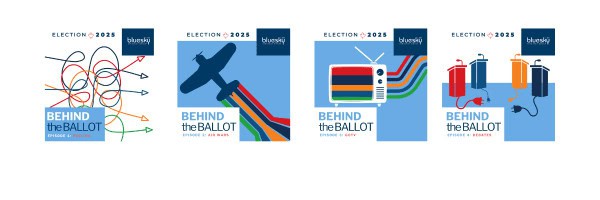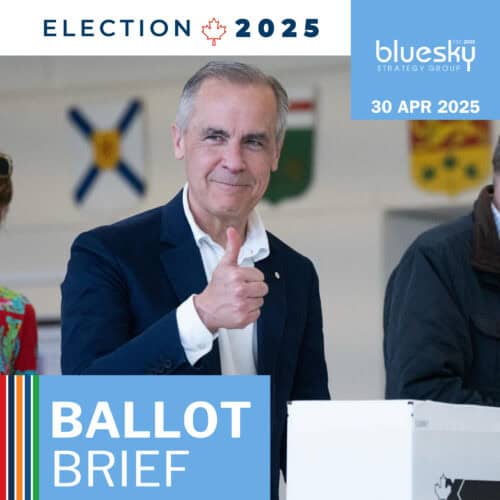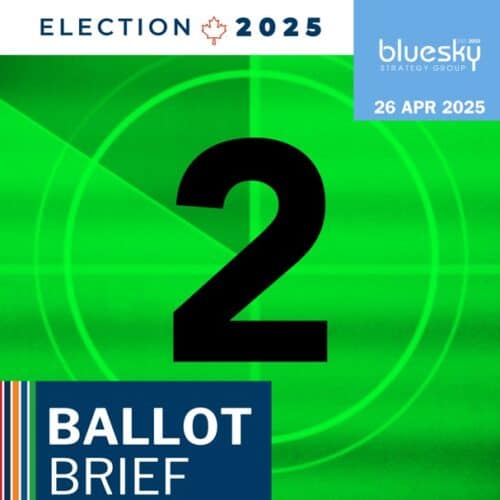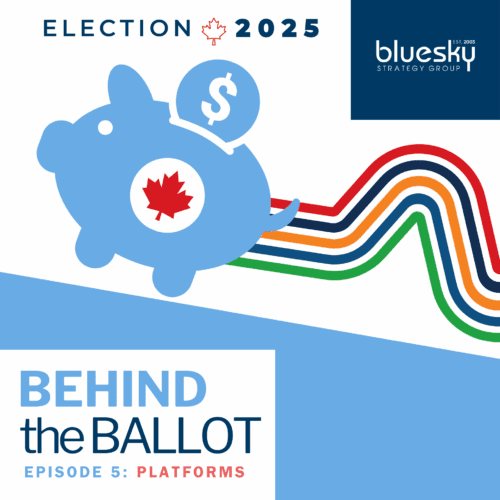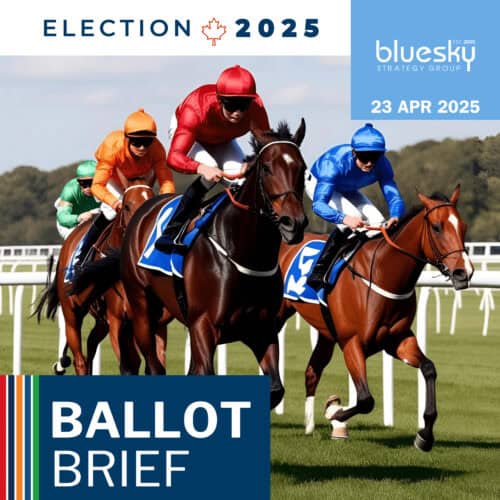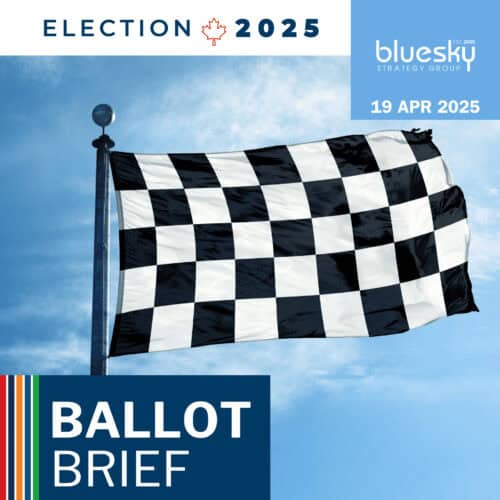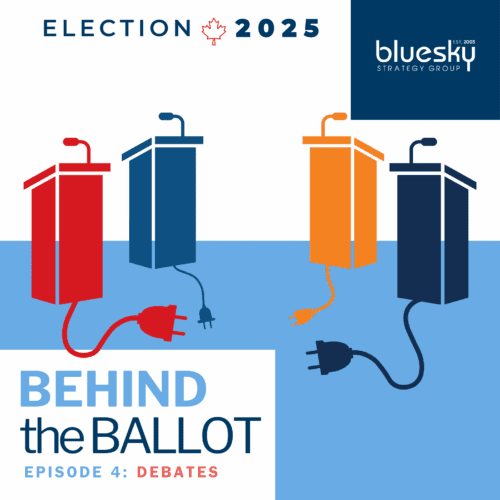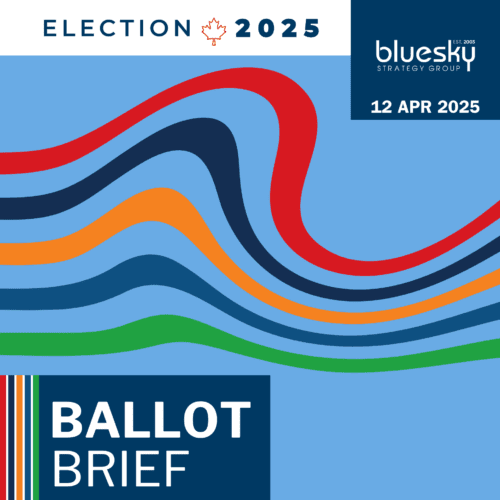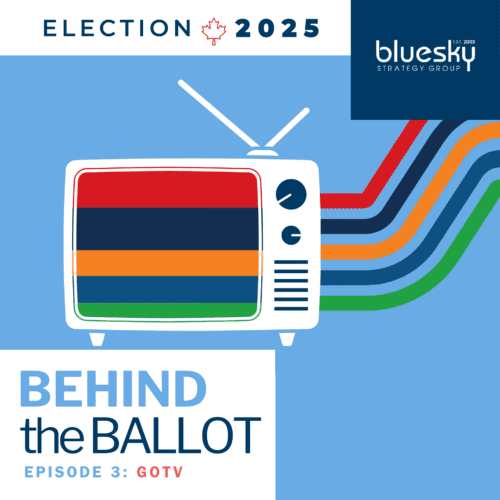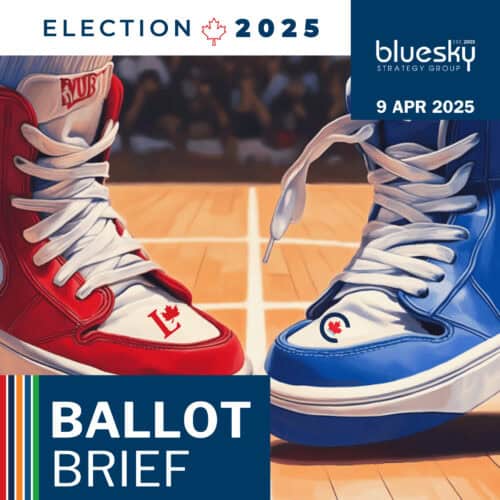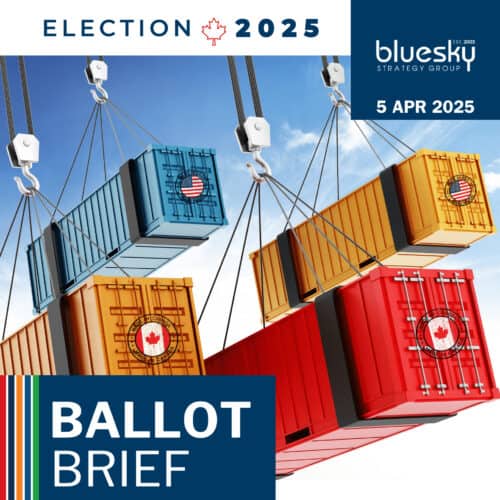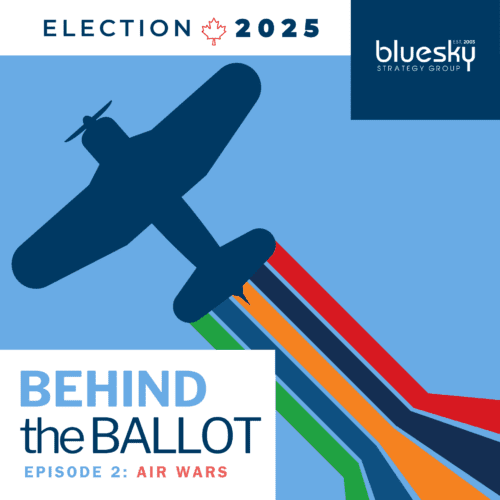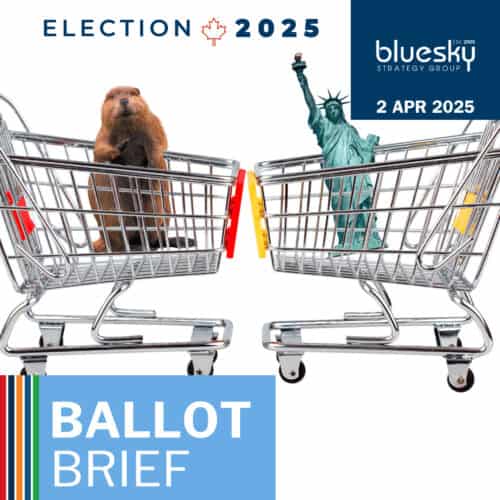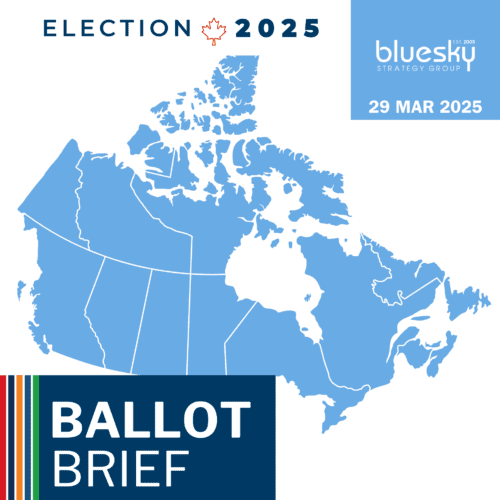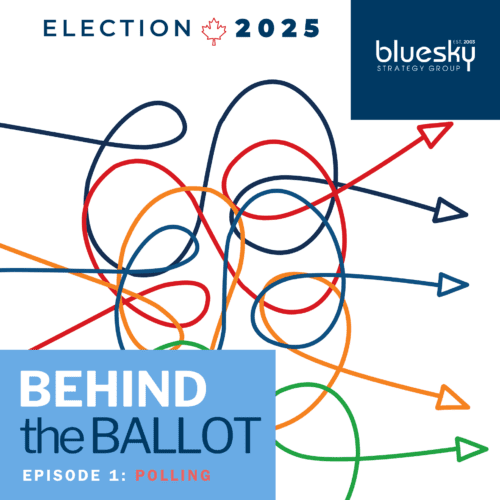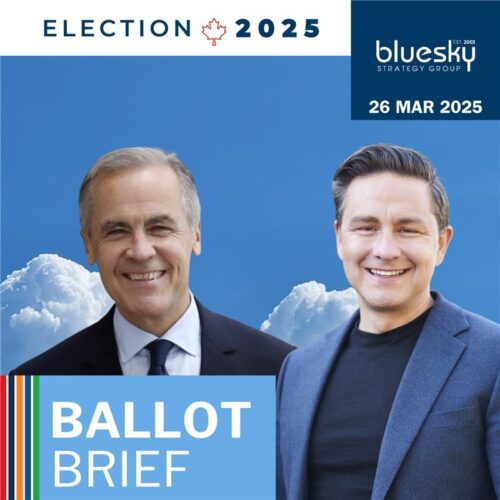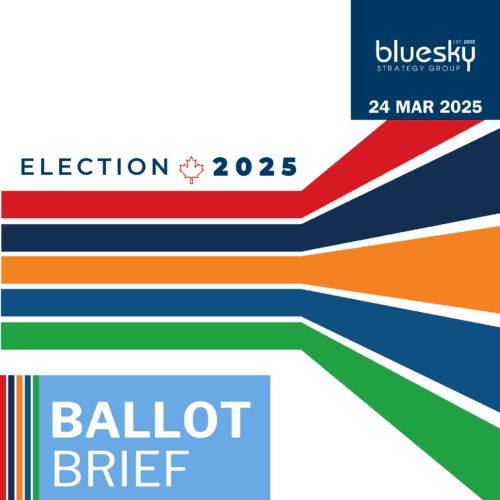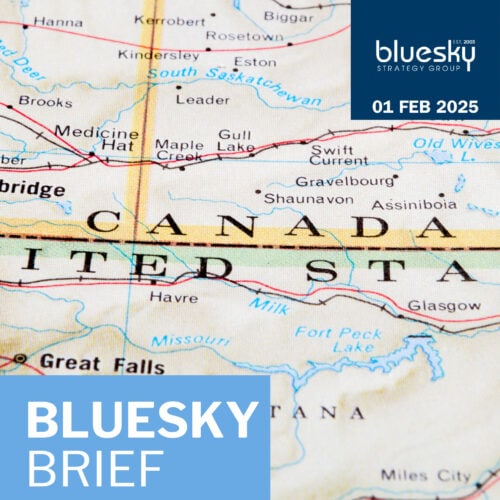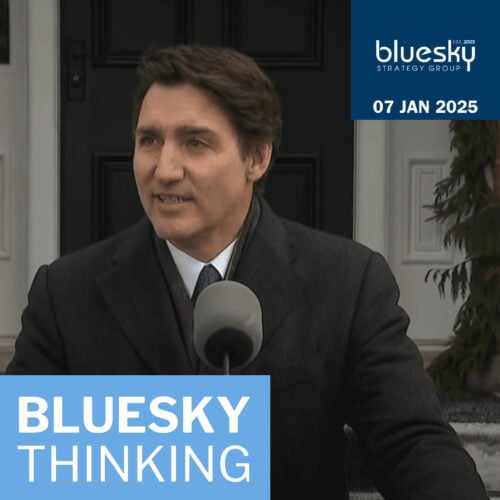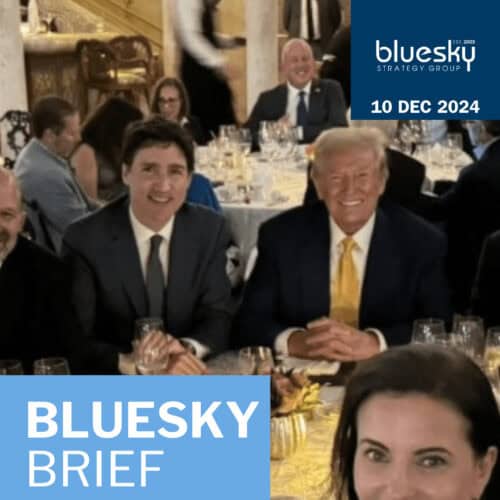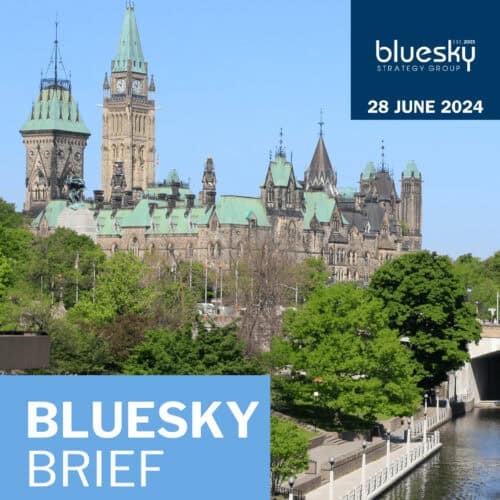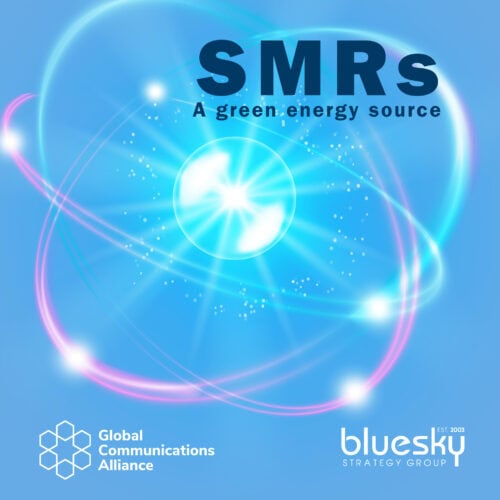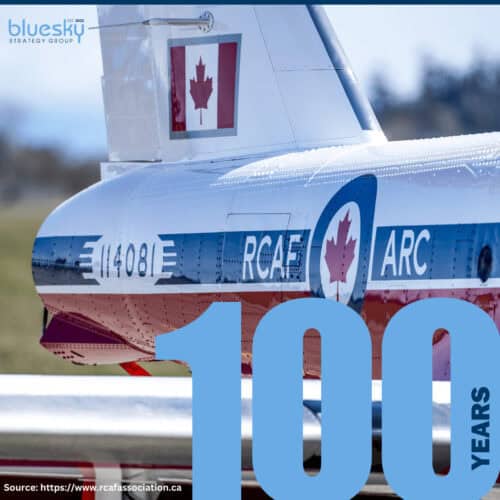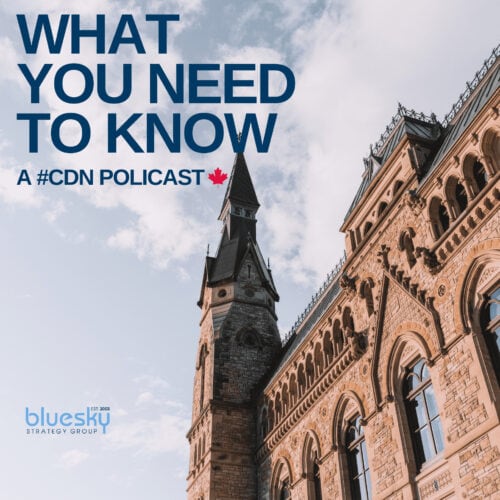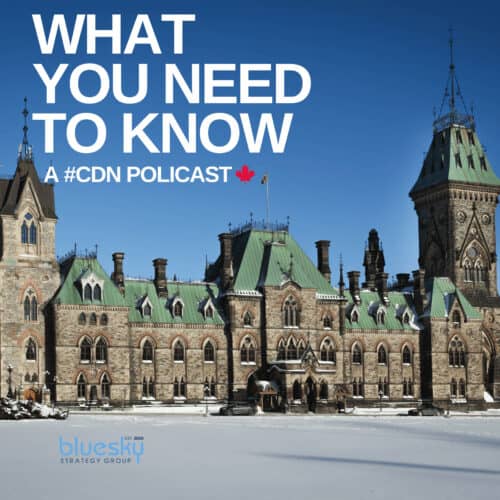After five weeks on the trail, it’s almost decision time. With record advance turnout and campaigns in overdrive, the finish line is in sight. In the last Ballot Brief before election day, we break down the closing moments, the final moves, and what’s left to watch.
The Rundown
With their platforms finally released, federal leaders are on the campaign trail, reinforcing commitments with targeted announcements. Here’s what each party has rolled out in the final sprint.
Economic Resilience: Liberal leader Mark Carney has pledged to defend Canadian workers and communities from Trump’s economic threats by boosting home construction, cutting housing taxes, investing in Canadian-made infrastructure, and maximizing steel, aluminum, and critical minerals. He has tailored his announcements to highlight provincial priorities—like auto jobs in Ontario and clean energy in B.C., while reinforcing a broader vision of national economic strength and resilience.
Restoring Affordability: Conservative leader Pierre Poilievre pledged to immediately repeal what he calls the “Car(ney) Tax,” a planned $20,000 levy on gas-powered vehicles, framing it as a threat to affordability and the Canadian auto sector. He also launched “100 Days of Change,” stating that a new Conservative government would lower living costs, scrap the carbon tax, crack down on crime, and unlock Canada’s resource economy, all aimed at reversing what he calls the “Lost Liberal Decade.”
Protecting Services: NDP leader Jagmeet Singh pledged to stop $28 billion in Liberal cuts to health care and social programs, and vowed to protect Canada’s water, health care, and Indigenous rights in future trade talks with Trump. The NDP’s plan focuses on safeguarding public services, tackling affordability, and strengthening national resilience through clean energy, good jobs, and tax fairness.
Environmental Protection: Bloc Québécois leader Yves-François Blanchet demanded Ottawa cancel a plan to bury 85,000 tonnes of PFAS-contaminated soil from Canadian Forces Base Bagotville. Citing health risks and past dumping in Mascouche, the Bloc calls for a moratorium on PFAS landfilling until proper treatment standards are in place.
Safe Campaigns: Green Party co-leader Elizabeth May condemned the rise in gender-based violence on the campaign trail, calling for urgent action to protect women, gender diverse, and LGBTQ2S+ candidates from harassment and threats.
The Inside Track
- Before we know the result on Monday evening, this weekend offers the final moments for leaders to grab national attention, rally the ground troops, and squeeze out any last opportunities to move the needle in close races or among key persuadable demographics. Local campaigns will wind down door knocking and work late into Sunday night, prepping their election day GOTV efforts. Scores of volunteers will fan out to chase every identified voter, urging them to get to the polls. They’ll close the day by observing the ballot count and calling in poll-by-poll results. This gives candidates and central campaign teams a short but critical lead time to tally results and prepare themselves accordingly before the race is called by the media. Our advice from advance polling stands: if you’re in their sights as a supporter, the best way to stop the calls and knocks is to go vote — they won’t come back once you do!
- Politicians always say the only poll that matters is on election day, and they’re right. While the polls have stayed relatively stable after the earlier tectonic reversal, some wild dynamics are still playing out. The story of the result will hinge on the diminishing fortunes of the NDP and Bloc. The Liberals have rebuilt a strong base and added wide swathes of NDP and Bloc voters to sit at 42 per cent support, slightly off their highs of 44 per cent. Whether that holds true and is enough to carry the day across many ridings when squaring off against the Conservatives remains to be seen. There are also several tight three-way races, especially in B.C., which will be decided on the strength of NDP results, including potential swings to the Conservatives, who often compete directly with the NDP in many rural and northern ridings. The Conservatives’ solid support, inching back up to 38 per cent, is not to be discounted. This is considered a level that would normally bring them to government, except in those scenarios, the NDP and Bloc are required to perform well and drive down Liberal votes, allowing Conservative pluralities to prevail.
- Carney is doing the front-runner’s sprint, sweeping across the nation, and playing poacher in pick-up ridings. No defence to be seen in the choice of destination or change of message. The Conservatives don’t appear to have that luxury. Their actions belie public denials, with the party redeploying precious staff resources to shore up the ground game in what should be safe ridings. The pundit class was tickled by sources from both parties confirming even Poilievre’s ultra-safe seat may be in play with the leader deciding to hold his final rally there Sunday, rather than, say, the GTA, where the path to government mostly lies.
- The Liberal leader was knocked somewhat off his game in the last two days, having to manage some aggressive questioning on the truthfulness of his dealings with Trump. He has had to field questions on whether he was telling the whole story about his call with the U.S. President. At the time, Carney told Canadians the call marked a shift in respect for sovereignty and the prime minister’s proper place. Media questioned how the U.S. president could be respecting sovereignty if with the usual “51st state” bloviating. Is this a Carney contradiction, or just “the cheese sliding off the cracker with this guy Trump?” Either way, media and opponents alike relished the opportunity to put the prime minister on the defensive.
- Poilievre launched the final stretch of the campaign yesterday in Saskatoon, where he announced that, if elected, his government would have Parliament sit throughout the summer until three key pieces of legislation — focused on affordability, crime, and jobs — are passed. Following the announcement, Poilievre held a large whistle-stop rally in Calgary near the airport, drawing a substantial crowd, before heading to B.C. for another energized rally in Nanaimo. Continuing to demonstrate the strength of enthusiastic supporters and ground troops has been a key strategy of the campaign, underpinning their high levels of support and organization that can win elections, despite the top-line polling numbers. After another rally in Delta, Poilievre will shift eastward to Ontario with a whistle-stop event later in the day in Sudbury. The final day of the campaign will see Poilievre hitting battleground Ontario, rolling his bus through Oakville, Pickering, and Peterborough, culminating with his final rally in Carleton, where he will close out from his home base.
- With just days left in the campaign, Singh is criss-crossing the Prairies and B.C. interior, urging supporters to “hold the line” in battleground ridings as the party fights to retain official party status and a national foothold. While Singh refocuses his messaging around workers’ rights, the campaign is showing signs of deeper trouble. In Quebec, several NDP candidates have been absent from local events, unreachable by media, or barely visible in their ridings, pointing to a disorganized and under-resourced operation in a province the party has struggled to reconnect with. Former NDP leader Tom Mulcair openly questioned Singh’s future earlier this week, telling CTV News he “can’t stay on” if the NDP fails to maintain official party status, warning that a poor showing would force a reckoning with Singh’s leadership and the party’s direction.
Races to Watch:
- Burnaby Central: Singh at risk in a redrawn riding as polls show the NDP trailing.
- Saanich—Gulf Islands: Elizabeth May in a dead heat with CPC; Greens could lose one of two seats and their leader in the House.
- Calgary Centre: The urban Calgary riding is now tied; a rare Liberal opportunity.
- Nepean: PM Mark Carney running for the first time; must-win for the Liberal leader.
- Carleton: Poilievre is safe, but the margin will reflect CPC strength as Liberals are making a strong display in the riding.
- Aurora—Oak Ridges—Richmond Hill: Classic 905 toss-up; key to majority paths.
- York Centre: Tight Liberal Saks vs. Conservative Baber race; test of Liberal urban base.
- Trois-Rivières: True three-way race (LPC/Bloc/CPC); unpredictable and high stakes.
- Long Range Mountains: Liberal name recognition vs. 2021 CPC near-win.
- Nunavut: Liberal Kabloona vs. NDP’s Idlout; close race with national implications.
Last acts:
- Carney will crescendo his campaign today with visits and rallies in the Greater Toronto area and Windso before returning to Lansdowne Park in Ottawa for election night.
- Today, Poilievre will rally with supporters in Delta, B.C., before doing it again with the home team on Sunday in his Carleton riding. He will be at the Rogers Centre Ottawa on Monday night.
- Singh will close out his campaign, and likely his party’s leadership, following a difficult result, with two events in Ontario before heading to his Burnaby, B.C., riding, where he will be as the results come in.
- Blanchette speaks to Quebecers today in the Abitibi-Témiscamingue region of Quebec before returning to Quebec City for Monday evening.
- Green Party co-leader Elizabeth May will be on Vancouver Island for her election night watch party, and co-leader Jonathan Pedneault will be in Montreal.
After the count:
Will we know before a late bedtime? With some B.C. races up in the air, it will depend on how the seat numbers stack up across the key foundations of any government — namely, the high volumes of seats in Quebec and the GTA — to determine who forms government, and whether it’s clear, tight, or too close to call.
Majority or minority — this is the question. It matters. With the NDP’s decline, the Bloc Québécois would likely hold the balance of power, and their willingness to be transactional on Quebec interests with either a Conservative or Liberal government will be key. As demonstrated in the last Parliament, the Liberals have more natural partners in a minority situation, while the Conservatives spent months sharply antagonizing other opposition parties when high in the polls, making few friends.
What’s next: Bluesky clients will get a full breakdown on Wednesday once results are confirmed. Generally, no party forming government will want to be caught sleeping on the job — expect an immediate push to get to work, given the chaotic context. We anticipate a cabinet named within 10 to 14 days, Parliament resuming by late May or early June, a Speech from the Throne setting out the agenda, and a budget tabled and likely attempted for passage before the summer break. Ottawa will be a buzzing town again — possibly sitting into the summer.
South of the Border
Trump signals higher Canadian auto tariffs: Besides reprising the “51st State” rhetoric, which pierced directly to the campaign trail, on April 23, Trump suggested that the existing 25 per cent tariff on Canadian automobile imports could be increased further. Framing the issue around domestic manufacturing, the president said: “All we’re doing is we’re saying, ‘We don’t want your cars, in all due respect.’ We want, really, to make our own cars.” The remarks have alarmed Canadian auto manufacturers already affected by the current tariff regime and raised concerns over the stability of cross-border supply chains.
Canadian leaders push back on U.S. trade rhetoric: In the final days before the election, Carney and Ontario Premier Doug Ford publicly rejected Trump’s latest trade threats. Carney emphasized Canada’s sovereignty over its auto industry, while Ford accused Trump of trying to “devastate” Canada’s economy. The comments underscore rising political and economic tensions as both countries approach expected post-election trade negotiations.
U.S. business leaders offer mixed tariff reactions: Major U.S. companies are voicing concerns about the impact of tariff uncertainty. Both Chipotle and PepsiCo reported higher input costs and reduced consumer activity linked to trade tensions. Whirlpool, which benefits from high domestic production, said it’s a “winner” under current U.S. tariff rules, but still reported a 19.4 per cent drop in net sales, citing negative effects from retaliatory tariffs, including in Canada. These mixed results highlight growing unease in the business community as trade friction escalates.
Hot… or Not?
Facts Matter: The Toronto Star spent time this campaign doing some targeted fact-checking. The outlet spent a different week following each of the three leaders, listening, reading and fact-checking. The good news, there were minimal challenges with truthiness among the three:
- Carney: Of 17 facts analyzed, 14 were considered true, one was false, one was a stretch, and one was unclear.
- Poilievre: Of 19 facts analyzed, 12 were true, one was false, five were a stretch, and one was unclear.
- Singh: Of 16 facts analyzed, 12 were true, one was false, one was a stretch, and two were unclear.
Advance! With record-breaking turnout at advance polls this election, it is noteworthy that the ridings where party leaders are the candidates topped the turnout list for the country. Poilievre’s Carleton riding had the highest advance turnout in the country, with almost half of eligible voters casting their ballots last weekend. Saanich-Gulf Islands, where Green Co-Leader Elizabeth May is running in B.C., came in with the second-highest turnout. And Nepean, where Carney is running, had the sixth highest. In past elections, a high voter turnout has most often represented a desire for change for voters – we will know Monday, if that adage holds, as 20 million Canadians are still eligible to cast their votes on Election Day.
Digital Rules: Canada’s political parties have been spending more on digital and social media advertising than ever before in this election. Just on Meta alone, more than $3.6M has been spent in the past 30 days, with the Liberals leading with 51 per cent, followed closely by the Conservatives with 45 per cent of the total spend.
Orange, Red, Red: Rod Loyola, the former NDP Alberta MLA who was named the Liberal Party candidate in Edmonton-Gateway before being dropped by the party, has received a cease and desist letter from the Liberals. Now running as an independent, it seems his signs are too confusing – he is using his campaign signs, produced for his run as a Liberal, with the Liberal branding covered over with an “Independent” sticker.
CARP Conundrum: An event hosted by the Canadian Association of Retired Persons with Poilievre as the main attraction has shed some light on how election spending rules may have been ignored. Some attendees felt the tone was too partisan, with Moses Znaimer, CEO of Zoomer Media and the CARP Chair, appearing to endorse the Conservative leader in his introduction, and too controlled with questions pre-planned. When asked, Znaimer confirmed that his organization had not registered with Elections Canada as a third-party. According to a piece in the Star, “Setting aside Zoomer Media’s objectives, using CARP’s membership list to court seniors to vote for the Conservatives appears to be a breach of Elections Canada rules.”
Bluesky Bonus
Bluesky On the Air: After their lively post-debate appearance, CPAC’s PrimeTime Politics welcomed back Bluesky’s dynamic duo of Principal and Co-founder Susan Smith and Vice-President Jordan Paquet to the strategists panel. This time, they broke down the fallout from Carney’s March phone call with President Trump.
Election Night Coverage: Team Bluesky is hitting the airwaves on election night! Susan Smith will be back on CPAC’s election panel Monday night, then up early Tuesday to share her take on CBC’s The Current. In the National Capital Region, Senior Consultant Alyson Fair will join Rogers TV’s election night coverage alongside Sam Laprade.
Missed Episode 5 of Behind the Ballot? In this episode, Senior Consultant Greg Loerts is joined by Sahir Khan, Executive Vice-President of the Institute of Fiscal Studies and Democracy (IFSD), for a timely breakdown of each party’s platform—and what the costing tells us. Watch the full episode here
Catch Up on Behind the Ballot: You can now stream every episode of Behind the Ballot on our YouTube Channel. We’ve covered everything from polling shifts and media messaging to on-the-ground strategy and debate takeaways, offering real-time analysis on what’s shaping Election 2025.
